Activities for the care of the city's hygiene and health system
Pandemics and the remedies for them
Between 1870 and 1915 San Remo had abandoned its character of ordinary provincial village and had become a tourist town of international renown.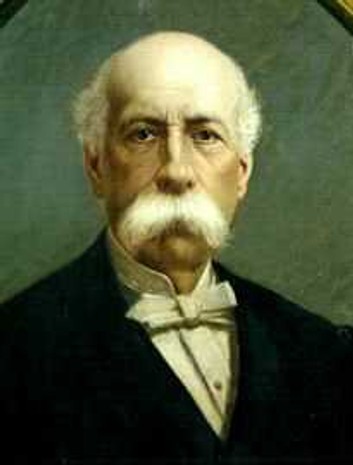 Certainly hygiene was one of the main issues to be resolved for all Italian towns in the aftermath of unification and Sanremo was no exception.
Certainly hygiene was one of the main issues to be resolved for all Italian towns in the aftermath of unification and Sanremo was no exception.
In the report presenting the Crispi law on hygiene and public health of 1888, known as "The National Health Code", which made it compulsory for municipalities to adopt Hygiene Regulations, it is stated that 6. 400 Italian municipalities lacked even the simplest sewers, in 1,148 there was no urban waste collection service, in 1,350 urban waste was simply collected in the courtyards, in 1,286 all the houses had no latrines, in 741 sewage was only drained when it rained.
Twenty years later, despite the renovations, the situation had only partially improved.
In the second half of the 19th century, for cities, as well as for climate stations such as San Remo, sanitation was a decisive issue, the resolution of which could not be postponed or prolonged.
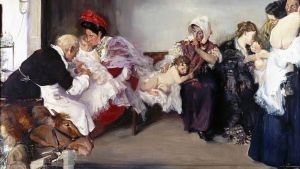 This is why, in the programmes of the various municipal administrations, the problem of the measures to be taken to prevent the infectious diseases that were decimating the population and infesting Europe in the 19th century had to be resolved.
This is why, in the programmes of the various municipal administrations, the problem of the measures to be taken to prevent the infectious diseases that were decimating the population and infesting Europe in the 19th century had to be resolved.
The bloodiest of these were cholera and smallpox, but tuberculosis, syphilis, measles, scarlet fever, diphtheria, typhus and leprosy were also causes of mortality.
At that time, there were no specialised hospitals capable of dealing with these types of pandemics; they were more like empirical cures, even though the doctors of the time did their best to deal with them.
Leprosy
A fair number of lepers were already present in Sanremo in the 18th century, probably the result of maritime traffic with the Orient or descendants of sick people who had been disembarked "in antiquity" from some Saracen vessel and abandoned on the nearby coasts, without a fixed abode, wandering and begging in the streets of the city were a very unedifying sight.
 Thanks to King Carlo Alberto, who was passing through Sanremo in 1853 on his way to Nice, he donated a considerable sum to modify part of the former Convent of San Nicola, near
Thanks to King Carlo Alberto, who was passing through Sanremo in 1853 on his way to Nice, he donated a considerable sum to modify part of the former Convent of San Nicola, near 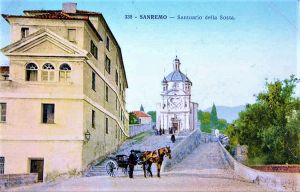 the Sanctuary of the Coast, to be used as a leper colony, thanks to the Piedmontese architect Ernesto Camous, to house and cure these unfortunate people.
the Sanctuary of the Coast, to be used as a leper colony, thanks to the Piedmontese architect Ernesto Camous, to house and cure these unfortunate people.
Later, in 1858, Vittorio Emanuele II, having become insufficient the old Napoleonic hospital located in the old convent next to the church of the Angels (former military district), had the remaining part of the building used as a hospital and gave it to the Mauritian Order. Only from that moment on did Sanremo have a real hospital, which would be of great use for the events to come.
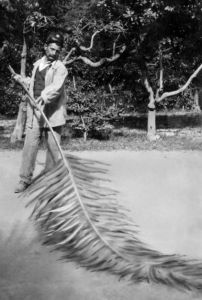 In Sanremo, since the twenties, a cleaning service of the town was carried out. Contracted out to private companies or managed economically by the municipality, this service was reduced to the "sweeping" of the main public streets. However, its efficiency left much to be desired, mainly due to the dirt surface of the city streets.
In Sanremo, since the twenties, a cleaning service of the town was carried out. Contracted out to private companies or managed economically by the municipality, this service was reduced to the "sweeping" of the main public streets. However, its efficiency left much to be desired, mainly due to the dirt surface of the city streets.
The work of "paving" and "cobbling" that was carried out from the 1960s onwards helped to improve the hygienic conditions of the streets, which remained very dusty.
After the construction in 1828 of the aqueduct commissioned by Mayor Carli, the most important public streets began to be "watered", albeit very sparingly and too rarely, but the modest nature of the city's water supply did not allow for better performance in those years.
A report by the Town Council to the Municipal Council of 31 May 1867 states that, « although the Administration has taken great care and some progress has been made with regard to the cleanliness of the main streets of the town, it has not been able to provide similar cleanliness in the mountainous parts of the town, nor has it been able to put an end to the inconveniences that are complained of with regard to the transport of rubbish, which is perhaps due to the scarce number of Municipal Guards and the inveterate and not very praiseworthy habits of a large part of our population ».
Venereal diseases
For this problem, within the framework of the Health Offices, the "visiting doctors" exercised their profession and were responsible for the health control of prostitution.
On 8 July 1869, the Minister of the Interior addressed the Prefect with this unusual recommendation:
« It is my understanding that in some health offices the visiting doctors admit medical assistants or medical students, or use voluntary substitutes to examine them in their absence. It is the intention of the Ministry that the service of examining prostitutes be carried out exclusively and personally by the visiting doctors, and without the intervention of outsiders, otherwise the guarantees of competition, ability and personal morality with which this very delicate service has been surrounded would be useless. In cases where it is indispensable to have a visiting doctor temporarily stand in for a justified absence or regular leave of absence, the Prefects alone must provide for this on their own initiative ».
During a meeting of the Sanremo Town Council, criticism was levelled at the service of the two doctors of the Hygiene Office. Bernardo Calvino refers to « the irregular way in which death certificates, i.e. reports of necropsy, are issued, noting that, for deaths occurring in the countryside, reports of examinations are issued, but no examinations are carried out; and the reports are therefore issued on the basis of a simple report from the relatives of the deceased, corroborated at most by the contribution of two witnesses taken from the scene; adding that sometimes, in order to get the dead person out of the house as quickly as possible, the report states that he died several hours earlier than the time he died; this certainly constitutes an act, an abuse, of the utmost gravity ».
The Municipal Council was instructed to "dismiss" the two doctors currently in charge in good time and to put forward proposals for restructuring the service.
1 - Cholera and smallpox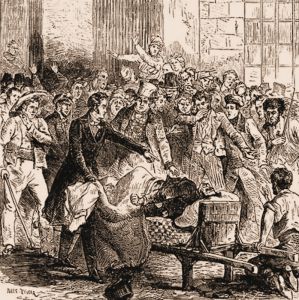 In the mid-XIXth century San Remo had twice been hit by cholera, first in 1837 and then in 1854, once by typhus in 1846 and once by a smallpox epidemic in 1829, years in which many deaths were recorded.
In the mid-XIXth century San Remo had twice been hit by cholera, first in 1837 and then in 1854, once by typhus in 1846 and once by a smallpox epidemic in 1829, years in which many deaths were recorded.
However, Sanremo had miraculously escaped the Asiatic cholera epidemic which had hit Marseille, Nice and Genoa hard in 1865-67.
In the years when tourism took off on the Riviera (see History of Tourism) cholera still appeared to be the most problematic of the recurring diseases, in fact it triggered frightening spirals of death and at the same time discredited the affected cities from a hygienic point of view, due to the causes believed to produce it.
There were two theories about the causes.
The first one believed that it was the "miasma" derived from bad cleanliness, and advocated municipal intervention to maintain cleanliness in houses and courtyards, ordering the removal of garbage thrown on lawns and streets, making the urban cleaning service more effective, washing streets, drains and sewers, distributing enough water, rationalising the evacuation system of faecal matter.
The second was more modern and more scientifically correct and already spoke of small living organisms attacking humans, making them sick and carrying the disease. The infected had the ability both to contaminate healthy substances and to infect other people directly, so they believed that in order to prevent epidemics it was necessary to work on the sanitary side by isolating the people affected, disinfecting the homes of the infected, destroying foodstuffs from places affected by cholera, and banning the movement of people and things during alarm periods.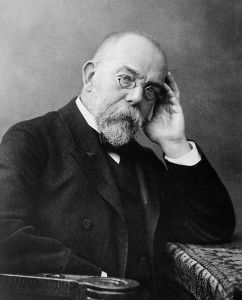
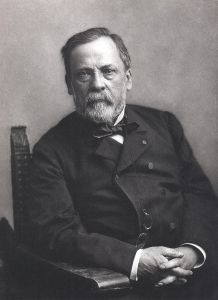 When, in the '80s, Koch isolated the carrier reservoir, demonstrating the scientific validity of the contagion theory, the conflicting positions of the two factions were reconciled and the existence of two different forms of the same disease was recognised: the common and the contagious.
When, in the '80s, Koch isolated the carrier reservoir, demonstrating the scientific validity of the contagion theory, the conflicting positions of the two factions were reconciled and the existence of two different forms of the same disease was recognised: the common and the contagious.
Between 1882 and 1915, despite the fact that both Koch and Pasteur, a proponent of preventive vaccination, had laid the foundations of the bacteriological theory of infectious diseases, public opinion, even though it now considered contagion to be a possible scientific truth, essentially continued to believe that consumption and cholera were caused primarily by the poor hygienic conditions of the cities where they mostly broke out.

From the report of the "Vice Conservator of Vaccine" of 1869 it is explained that « Jenner, with his prodigious discovery, has taught us the means of ticking off the scythe at death, which with smallpox reaped endless victims; and if this means, eminently useful and necessary for public safety, were put into practice in the times indicated and prescribed by the law on vaccinations, we would no longer see the Province from time to time polluted by the Arab and deadly disease.
If, after the publication of this law, it has not been able to assume the proportions and characteristics of a widespread and serious epidemic, it has always, when introduced, claimed a few victims.
The vaccine that I have introduced is the offspring of the one discovered in the Province at the end of July last year: I have not yet observed any significant modification in its course, in the intensity of its symptoms and in its duration; and if it has sometimes presented some variation in its phenomenal aspect, I have always recognised that this must be attributed exclusively to the constitution and indisposition of the vaccinated person: it is also recognised that this vaccine enjoys greater virtues of transmission than the one that has already been passed on for many generations; whether it also enjoys greater virtues of preservation I do not know, time will show ».
A resurgence of smallpox disease was reported in 1872:
« The Provincial Board of Health, informed of the appearance of smallpox in the province and in some localities with quite considerable proportions, although aware that fortunately it is now decreasing, has nevertheless decided that given the approach of the summer season and certain local conditions the following measures to protect public health were necessary:
- not to admit to public or public schools those pupils who present fresh traces of smallpox recently suffered or who have smallpox individuals at home;
- if any person living in any of the above mentioned establishments was affected by smallpox or could have contact with smallpox, he should be immediately isolated and transported elsewhere, and when this was not possible the school should be temporarily closed giving notice at the same time to the Prefecture ».
In 1873 Dr. Raffaele Baratta of Pornassio discovered the original vaccine in the cows on our Alps of Lote and Tanarello: but since its efficacy did not last longer than 24 hours, it was recommended to report any infected cattle in our countryside to obtain the vaccine in less time.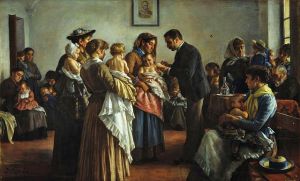 A further increase in the number of smallpox cases was reported in 1881 so it was recommended to avoid the use of public cars and railways to transport the affected people to the hospital in order to limit the spread of the disease.
A further increase in the number of smallpox cases was reported in 1881 so it was recommended to avoid the use of public cars and railways to transport the affected people to the hospital in order to limit the spread of the disease.
With a "Public Health Ordinance" of 1890, while noting that smallpox was in sharp decline, it was decided that all persons living in a building where a case of smallpox had occurred were obliged to undergo vaccination, regardless of whether they had already been vaccinated.
Things are going better in the whole Kingdom, but since in 1894 smallpox cases occurred in some places in France close to our border, the Mayors of the province are invited to « exercise a surveillance activity and adopt those preventive measures whose effectiveness to prevent the spread of this disease has been consecrated by a long practice ».
In the province the 61 cases of smallpox which occurred in 1894, fell to 25 the following year with 2 cases in San Remo (from Monaco).
Cholera, which claimed a large number of victims, caused the greatest concern.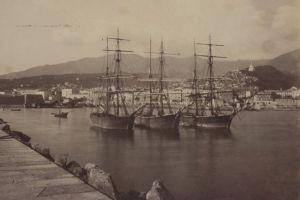 In 1870, a ministerial order was issued concerning the measures to be taken against ships coming from the Sea of Azov because of the development of cholera in Tagaurog. In the case of ships that had not served a regular in absentia in Constantinople or another intermediate port prior to arrival, the observation of the Sanitarians could only take place in ports or ports of call where complete isolation of the ships was possible.
In 1870, a ministerial order was issued concerning the measures to be taken against ships coming from the Sea of Azov because of the development of cholera in Tagaurog. In the case of ships that had not served a regular in absentia in Constantinople or another intermediate port prior to arrival, the observation of the Sanitarians could only take place in ports or ports of call where complete isolation of the ships was possible.
However, the official appearance of cholera in Italy was reported in 1873 and the Prefect promptly alerted the mayors:
« As Your Excellency may have learned from the newspapers, and as confirmed by a communication published a few days ago in the Official Gazette of the Kingdom, it seems to have been ascertained that cases of Asiatic cholera have appeared in some municipalities in the provinces of Treviso and Venice.
Although it is to be hoped that the fatal disease may remain confined to those municipalities, and that the sanitary conditions of this Province are excellent, it is not therefore the case that all the Authorities, especially the Municipal Authorities and the advisory bodies responsible by law for the protection of public health, have been able to prevent the disease from spreading.
Therefore, all the Authorities, especially the Municipal ones and the advisory bodies assigned by law to the protection of public health, must redouble their vigilance so that in every locality and especially in the most populated centres, all the hygienic prescriptions recommended by science and experience are scrupulously observed and carried out, in order to prevent the development of epidemic and contagious diseases.
These concern in particular the cleanliness of inhabited sites, the temperate ventilation of dwellings, and in particular of public establishments, the disposal of stagnant water, as well as the wholesomeness of foodstuffs placed on public sale and similar other precautions.
In the case of a well-founded fear that the aforementioned disease could also invade this Province, it will be the responsibility of the Municipal Representation to prepare everything necessary both for the care of the poor who are affected by the aforementioned disease, and to prevent its greater spread and diminish its disastrous and terrible effects. ».
A special poster, dated 26th July 1873, was also posted:
On 6th January 1874 the "cessation of cholera in the whole territory of the Kingdom" was ascertained.
After a decade the Prefect wrote to the Mayors in a letter dated 8th July 1883:
« Your Lordships will not be unaware that Asian cholera has appeared in nearby Egypt and that the terrible disease is spreading and worsening in that country, claiming numerous victims.
The sanitary measures that have been taken by the King's government are such as to reassure people, and it is to be hoped that they will be sufficient to keep the epidemic invasion away from Italy.
Nevertheless, and wisely foreseeing even the distant possibility that the disease may spread to these countries, it is necessary to be prepared so that, in the event, the epidemic may be more easily controlled and circumscribed ».
The letter goes on to make the well-known recommendations on prophylactic measures to be taken.
Further warnings followed in the same year:
« Following up on the previous circular, I must point out that the epidemic, in order to enter the borders of the State, can take both the sea route and the land route: in fact, sometimes a cloth, a rag, or any object containing the germs of the lethal disease is enough to make it break out in the country where the object is imported.
Arrangements have been made with the Intendant of Finance for the customs guards to concur in the sanitary vigilance, and I am convinced that the concurrence of that Corps will be a valid aid in safeguarding us from cholera.
However, since the precautions taken can never be too many, it is necessary that in this work the agents of the finance be helped effectively and in agreement by the people themselves. Now that the import of certain goods for sanitary purposes has been suspended, now that incoming ships have to undergo quarantine of greater or lesser duration depending on their origin, it is foreseeable that the clandestine introduction of goods will be attempted on a larger scale, and perhaps to the serious detriment of public health ».
The Municipal Council, in its meeting of 9 August 1883, resolved on urgent and important interventions for the construction of sewers, as requested by the Health Authority, « also in view of the dangers threatening public health in the Mediterranean countries, given the appearance and raging cholera in Egypt ».
In October 1883, a "Maritime Health Order, having « ascertained from official information that the sanitary conditions of the islands of Malta and Cyprus, of the city of Smyrna and of the whole of Syria remain satisfactory, decrees that the quarantine now in force for ships of the said origin, which have arrived with unharmed crossings, whatever their duration, is now reduced to 24 hours; and that, having also noted the considerable improvement in the sanitary conditions of Egypt and of all ports beyond the Suez Canal, the quarantine of ships coming from there will from today be established at 10 days without distinction ».
The order was then revoked on 24 March 1884.
But in the same year, the Prefect informed the Mayors: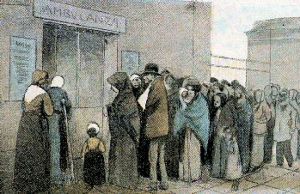 « Your Honours will probably be aware that in neighbouring France, and more precisely in the city of Toulon, a number of cases of a disease that has all the characteristics of Asiatic cholera and was defined as such, have appeared in recent days.
« Your Honours will probably be aware that in neighbouring France, and more precisely in the city of Toulon, a number of cases of a disease that has all the characteristics of Asiatic cholera and was defined as such, have appeared in recent days.
In view of this, the King's Government has taken strict sanitary measures to reassure people and it is to be hoped that these will be sufficient to keep the disease away from Italy.
However, since it is foreseeable, as prudence would have it, that the epidemic may spread to these countries, it is necessary to be prepared in order to be able to control and contain it more easily.
I therefore order that the mayors should already be thinking about the premises in which the lazaret for the cholera sufferers could be established, so that they will not be caught unawares in the event of a cholera invasion ».
2 - Attempts to improve urban hygiene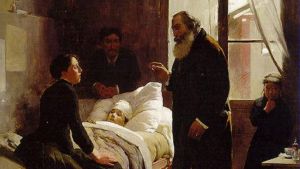 If Sanremo wanted to have a future as a health resort, therefore, it had first of all to prevent the danger of epidemics, improving hygiene and then proceeding with vaccinations.
If Sanremo wanted to have a future as a health resort, therefore, it had first of all to prevent the danger of epidemics, improving hygiene and then proceeding with vaccinations.
A further impetus for this was the numerous failures that occurred in Nice due to the absence of tourists because of the cholera epidemic. Tourists, who came from far away and travelled at great expense, wanted to find places to treat themselves, not to fall ill. It was unthinkable that wealthy tourists from the north would be willing to walk among piles of rubbish or 'foul and nauseating fumes' from cesspits or open sewage drains.
On the other hand, even if they were not particularly affected by all this, they would have demanded more urban cleanliness, and above all enough running water.
In 1871, when the foreign colony began to take on a certain consistency, thanks to the measures concerning cleanliness, although the conditions of the busiest urban streets could be considered satisfactory, there was no lack of complaints, generally in the form of letters sent to local periodicals, and almost exclusively concerning the situation of the hillside areas, secondary roads, private roads, and courtyards inside the buildings.
In the second half of the 1860s, a Sanitary Commission was set up, which was entrusted with a "Report on the hygienic state of San Remo", whose members held office for four years, and whose function was to present to the council the measures to be approved in the interest of urban hygiene.
The report of the members of the Sanitary Commission, in charge of the inspection, began as follows:
«... If it is generally rumoured that cleanliness in the upper part of the town is little cared for, those who reported it were persuaded that, on the contrary, the evil is much stronger in the lower part of the town, where, to tell the truth, judging by the streets that are daily swept, one would be inclined to believe the vulgar belief; But if, as the undersigned did, one goes into certain alleys, mountains, and hollows commonly existing behind the houses towards the gardens, one is amazed at the rubbish accumulated there; And it is astonishing how the inhabitants of the houses that watch over those filthy receptacles of filth, adapt, without complaint, to breathe the fetid fumes, and indeed with the continuous flow of every liquid and solid household waste, feed with the utmost indifference this source of miasma, so much so that it is believed that they have now lost the sense of smell ».
The report contained a detailed list of the places where urgent action was needed to avoid the danger of epidemics and to avoid leaving holidaymakers hungry, as well as a handbook of the types of action considered most appropriate.
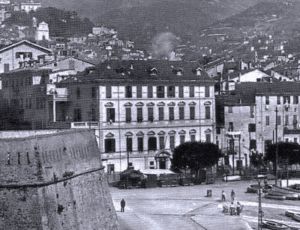 One of the many similar cases reported by the health inspectors concerned the central and monumental palazzo della Dogana, behind which,
One of the many similar cases reported by the health inspectors concerned the central and monumental palazzo della Dogana, behind which,
«... there is also a cavity with no outlet and full of garbage, but there, what is most repugnant and requires immediate shelter, is a small room on the ground floor with an open door at the side of the trattoria del Vapore, where the showers of all the toilets in the building have their outlet, to such an extent that natural excrement over a metre high can be seen in this room, and which, owing to the constant agitation produced by the matter falling from the top of the gargoyles, gives off an asphyxiating stench ».
Another case of a different nature but of equal seriousness concerned:
«...the beodo that passes through the kintagna, and the passage of that name, which are horrible things to see, especially behind the slaughterhouse in Viale Giovanni, where such a quantity of putrid water mixed with slaughterhouse blood stagnates that even the most indifferent man would be repulsed ».
In August 1871 Mayor Corradi received the results of this investigation, which he himself had requested and which give a clear picture of the conditions of Sanremo at the beginning of its touristic history and it was to change this sanitary status that also the following municipal administrations engaged in a wide range of corrective measures.
In the seventies so they intervened a lot on specific cases, reported from time to time by the sanitary inspectors, while on a general level they started to provide the city with public urinals.
In 1883, even before the aforementioned Crispi law of 1888, the city of San Remo approved the Regulation of Hygiene, updated in 1893 and substituted in 1901 by the Regulation for the hygiene of the soil and the inhabited area of the city of San Remo, in turn modified in 1909, 1911 and 1913, based on the new municipal and provincial laws and ministerials, which established the general criteria to which the various local regulations would have to adhere.
The various sanitation regulations in Sanremo, although they did not differ greatly from one another, prohibited any work that endangered the natural flow of rainwater, for which there were drainage canals along the streets; they prohibited the discharge of the contents of latrines and unclean water into streams, the sea or white canals; they imposed the paving of all urban streets with impermeable materials; They established rules for issuing the certificate of habitability for houses; they granted the mayor the power to withdraw habitability from flats considered unhealthy; they prescribed the paving of courtyards, which had to be kept free of rubbish at all times; they made latrines compulsory in the houses; they regulated the systems for collecting faecal matter and sewage; and they prohibited stables and deposits of manure and rubbish in the built-up area. Lastly, they contained provisions for drinking water pipes, wells, cisterns and wash houses.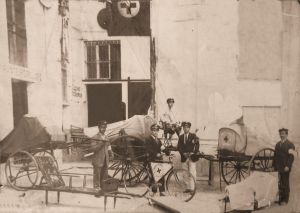 In the second half of the 1880s and in the course of the following decade, a Hygiene Office was set up, provisions were made for the slaughter of meat, a network of outlets for street washing was created, modern lavatories were built and the slaughterhouse in Valle Armea, outside the town, was finally completed.
In the second half of the 1880s and in the course of the following decade, a Hygiene Office was set up, provisions were made for the slaughter of meat, a network of outlets for street washing was created, modern lavatories were built and the slaughterhouse in Valle Armea, outside the town, was finally completed.
In January 1884, Dr Warlomont, director of the International Ophthalmic Institute based in San Remo, wrote a letter to the Mayor in which he, « animated by the desire to contribute to the well-being and growth of this city, communicates to the Council a fragment or chapter of a book, soon to be published in Paris and Brussels under the title "Ou faut-il passer ses hivers? (Where should one spend one's winters?), which fragment deals with the healthiness of dwellings in relation to the transmissibility and infectiousness of tuberculosis, and contains various proposals to provide for this healthiness in an appropriate manner ».
In the meantime, however, the various Administrations, both municipal and provincial, often recommended keeping a close watch on the dangers of contagions, especially cholera and smallpox, which were still circulating in various parts of the country.
In November 1884 it was reported that cholera had disappeared from all parts of the Kingdom, except for a few cases.
However, in the session of 28 June 1884 the Council decided as a matter of urgency, "in view of the danger of a cholera invasion", to authorise the Mayor to issue all the necessary measures and carry out all the necessary works in the interest and for the protection of public health.
In 1885, however, cholera broke out in Marseille and a strict medical examination of people entering the Kingdom and their luggage was immediately carried out on all the main communication routes on the borders between Italy and France.
The Minister of the Interior orders that
« - Every railway train travelling from Ventimiglia to Savona shall have a special carriage with a latrine for the accommodation and treatment of travellers suffering from a suspected illness during the journey;
- this wagon shall be escorted by sufficient medical staff and supplied with medicines, disinfectants and everything necessary to treat the sick;
- the sick persons admitted in the hospital wagon will be deposited at the nearest station, which will have suitable rooms for receiving them in isolation;
- when it is necessary to deposit a traveller suffering from a suspected illness in a Municipality, the Municipal Authority must be informed in advance by the Station Master, in order to agree with them the precautions to be taken when transporting the sick to the premises set aside for treatment ».
In 1885, the Prefect made a number of recommendations to the mayors: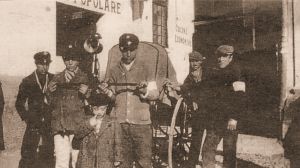 « The summer season is approaching, the season that is most favourable for the development of epidemic diseases. And since there are no signs of the return of the disease that unfortunately infested the town last year, we cannot deny the need to adopt preventive measures to prevent the generation and spread of any infectious disease, and especially to remove any source of infection by keeping the streets, squares, schools and other public places as clean as possible, as well as inside and around private homes.
« The summer season is approaching, the season that is most favourable for the development of epidemic diseases. And since there are no signs of the return of the disease that unfortunately infested the town last year, we cannot deny the need to adopt preventive measures to prevent the generation and spread of any infectious disease, and especially to remove any source of infection by keeping the streets, squares, schools and other public places as clean as possible, as well as inside and around private homes.
It is also agreed that, in addition to the vigilance attributed by law to the municipal authority, which must be very strict, regarding the quality of foodstuffs and drinks offered for sale, and the wholesomeness of drinking water, the municipal representatives should endeavour to make their fellow citizens understand that, in order to be in good health and thus be able to resist the onslaught of disease, it is also necessary to take care of the cleanliness of the person, adopt a healthy diet, avoid disorders of all kinds and during the summer be moderate in the use of fruit.
Moreover, it is not enough to meet the needs of the present, we must also take care of the future, i.e., to ensure that the observance of the above-mentioned rules of hygiene enters into the habits of the people so that the new generations grow up healthy and robust and can thus improve their conditions both moral and material, since it is proven that the development of intelligence usually goes hand in hand with the development and invigoration of the body.
The painful fact that in this Province, although so favoured by nature, there are many young men who are declared unfit for military service due to a lack of physical development leads me to call the attention of the municipal administrations to this ».
But in 1886 the epidemic spread throughout the Kingdom and the Prefect informed the Mayor that « the Municipality of Rome, to which the King's August Majesty, moved by the announcement of the grave misfortunes that the cholera epidemic was spreading among its people, gave the most noble mandate to collect abundant donations from the whole nation to help so much misery and alleviate such acute pain, is addressing through me the moral bodies of this province to help the poor, commissioned the most noble mandate to collect from the charity of the whole nation copious offerings to help so many miseries and soothe such acute pains, addresses through me the moral bodies of this province in order to obtain their generous help.
In informing Your Excellency of this, I beg you to share it with the Municipal Council, inviting it to vote, within the limits of the municipal finances, for aid for those affected by the scourge.
I would also ask you to address a similar invitation to the moral organisations existing in this Municipality which have as their objective charity, savings, mutual aid and welfare, and to stimulate all the patriotic societies and mutual aid, professional and recreational associations etc. to take up this noble enterprise, so that they may allocate funds to increase their funds, To stimulate all patriotic societies and mutual aid, professional, or recreational associations etc., to increase the funds of charity by means of some of their collective or personal offerings, and to encourage everyone, wherever possible, to open subscriptions in newspapers and to promote expedients, such as public lotteries, raffles, regattas, theatrical performances, musical performances, concerts, paid recreational evenings, the placing of alms urns in public places to collect charitable donations, etc. ».
After affecting more than 50,000 people, with over 2,000 deaths, the disease subsided the following year.
In anticipation of the 1887 summer season, the Prefect wrote:
« The sanitary conditions of the Kingdom are satisfactory, and everything leads us to believe that the present state of safety can continue in the long term.
But such a hope should not prevent the authorities responsible for the protection of public health from attempting all means to avert even the remotest possibility of danger before the summer season arrives, both in the municipalities that in the past year were more or less infested with cholera, and in all the others ».
1887 was also the year of the earthquake that devastated entire municipalities in the Province and on 20 July the Prefect reiterated:
« Now that the heat is in full swing, and is all too favourable to the manifestation of epidemic diseases, it is more necessary than ever that mayors do their utmost to take care of public hygiene, especially in those municipalities whose population lives in huts.
The experience of recent years, during which epidemics have followed one another, now in one part of the Kingdom and now in another, has clearly shown that cleanliness is one of the most effective preservers of diseases, especially those of a diffusive nature.
I therefore deem it opportune, although the sanitary conditions of our Province are satisfactory, to strongly recommend the cleaning of the streets and public squares, especially where rubble is still piled up, and to order their immediate removal, or at least their disinfection with chloride of lime dissolved in water, as well as public and private toilets, and especially those of hotels and public establishments, through which contagious diseases could easily be spread by travellers. They shall also order the immediate removal of dung and manure deposits of any kind that are found in the built-up area or near public squares and streets.
In those municipalities where the population, or part of it, lives in huts, the implementation of the above-mentioned suggestions is even more recommended, practising frequent cleaning and disinfection of the huts, and avoiding agglomerations of people in enclosed places, so that breathing does not become difficult and pernicious ».
This was followed by a period of relative tranquillity until, in 1892, Minister Giolitti wrote:
« The threatening spread of the cholera epidemic in countries bordering ours or with ours in continuous and important commercial relations, makes it imperative for all provincial and municipal health authorities to assist, with their most scrupulous vigilance, the work of the Government, in order to prevent the feared infection from making its way into the country and, in the unfortunate event that this should happen, to ensure that it does not find it easy to take root and spread among our populations, and that any possible first outbreaks of the disease are immediately suffocated ».
Detailed instructions to prevent the development and spread of cholera were attached to the circular.
The following year, the number of cholera cases in the south of France increased and border health controls were intensified. This did not prevent 10 cases from occurring in the Province of Porto Maurizio.
In the meantime, at the council meeting of 22 October 1889, the mayor reported on the city's cleaning service, saying that « it is provided "with women on a daily basis", by the council and by the urban police ».
It is true that there is the inconvenience of piles of rubbish being deposited along the streets late in the evening by those families who have no way of exporting it, but there are difficulties in providing a more suitable service. 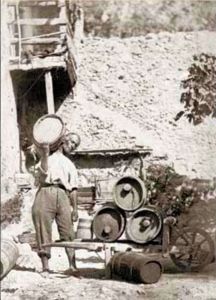 Moreover, the rubbish is collected in special places, from which it is removed by a carter who, for some time, paid the Municipality £1 per day.
Moreover, the rubbish is collected in special places, from which it is removed by a carter who, for some time, paid the Municipality £1 per day. 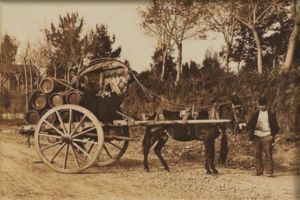 It would now be necessary to find a way of providing for this; perhaps a cart with a bell, as is used in other major cities, would be appropriate.
It would now be necessary to find a way of providing for this; perhaps a cart with a bell, as is used in other major cities, would be appropriate.
Councillor engineer Ernesto Marsaglia « suggests the use of deposits in suitable rooms inside the houses. Or, according to him, the sweepers could be obliged to collect the rubbish directly from the families, without obliging them to pay any fee.
Stating that the latter method was used in the City of Genoa, councillor Vincenzo Manuel Gismondi recommended it to the Council, which "willingly accepted the Mayor's recommendation ».
In 1890, the Municipal Council decided to build a section of masonry sewer in the S. Romolo stream between the Market Square and the railway bridge, and to lay a cast-iron pipe from the bridge to the sea, where the pipe will be buried for 20 metres.
In the same year, it was decided to build a disinfecting oven using the superheated steam method, with which "it is possible to disinfect 50 complete beds in one day".
The plant was to be built "in the area of land to the west of the fort near the sea".
At the council meeting of 26 October 1891, councillor Vincenzo Manuel-Gismondi, in dealing with budgetary expenditure, proposed « a suitable increase to improve the daily pay of the public sweepers. He notes that they are often forced to resort to public charity; that they carry out painful work that is not free from illness ».
The President, Mayor Alessandro Escoffier, considers the proposal to be fair, as the sweepers' pay is very small. « except that it should be noted that this serves as an excuse for them to resort to the Charity Committee. It should also be noted that their daily work is limited to the early morning and evening hours, so that they have the opportunity to earn some money from other services that they can perform on their own. It should also be borne in mind that the municipal administration, preferably and if necessary, employs the sweepers in other jobs paid for separately ». He concluded by stating that even if they were paid more, the service would not be any better or more.
While leaving the proposed allocation as it is, councillor Augusto Mombello believes that the Council should study and resolve the matter, « as it is not honourable for the Municipality to be told how it keeps poorly paid people in its service. He then recommends that the council itself purchase a machine for sweeping the streets ».
At the council meeting of 27 August 1900, the councillor Paolo Eugenio Carbonetto "briefly outlines the proposal, made some time ago, « for the purchase of a mechanical sweeper drawn by horses, and mentions the advantages of the system adopted elsewhere, with savings in the cost of cleaning the streets and other public spaces ».
In this regard, the Councillor, Engineer Antonio Tornatore, reports that the Council has for some time now been carrying out the appropriate studies for the choice of a suitable sweeper system, and has made the necessary arrangements for the purchase of the machine and its price.
He then announces that he has opened negotiations with the industrial company Gola & Canelli of Milan, who would be obliged to supply a Barrows sweeper to a horse, at the price of £1,150.
He describes the form and operation of the machine, demonstrates the advantages to be gained, and proposes that it be purchased. Acknowledging the convenience of the proposal, the Council, without discussion and by full agreement, approves it.
In 1894, the Bureau of Hygiene was provided with the necessary equipment to carry out the chemical examination of foodstuffs.
The following year a « better system of public wash-houses was provided, with a view to avoiding the washing of clothes which, at present, is done in communion, with the possible damage of communicating certain serious diseases ».
In the budget for 1898, the allocation of £1,423 for the maintenance of lepers in San Remo was increased.
In 1900, the Council of 24 August approved the insertion of the following new article in the Hygiene Regulations: « Within the perimeter of the city, which extends from the sea to the height of the Sanctuary of the Assumption, and from the Val d'olivi stream to the Bernardo stream, it is forbidden to beat carpets and other objects used in inns, villas and houses in order to remove them, except in those places that will be designated from time to time by the Mayor, after hearing the opinion, in writing, of the Health Officer ».
At the beginning of the new century, conditions in the city could justifiably be considered much improved. The measures adopted by the council, the administrative sanctions passed by the council, the actions of the urban police force, as well as an evolution in the hygienic habits of the people of Sanremo had made garbage disappear even from courtyards and side streets.
The Sanremo of the Belle Époque was now an avant-garde tourist resort, where the "sweeping" of the streets was largely mechanised and where the "watering" of the streets was punctual and efficient, thanks to the quantity of drinking water now available thanks to the new Marsaglia Aqueduct. This side of the hygiene issue had therefore been partially resolved.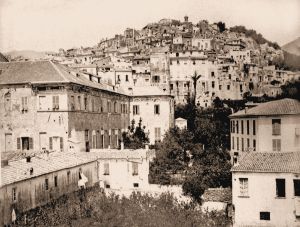 We say partially because the healthy part of the city was only that formed by the suburban residential districts and the business centre on the plain, while in the "old" city the hygienic conditions had remained the same as they were two decades earlier, with its unhealthy buildings and smelly alleys. This was the real issue: the problems were not taken into consideration by the successive administrations, according to their absolute seriousness, but only because they could damage the development of tourism.
We say partially because the healthy part of the city was only that formed by the suburban residential districts and the business centre on the plain, while in the "old" city the hygienic conditions had remained the same as they were two decades earlier, with its unhealthy buildings and smelly alleys. This was the real issue: the problems were not taken into consideration by the successive administrations, according to their absolute seriousness, but only because they could damage the development of tourism.
With regard to the question of hygiene, the organisation of the health system to prevent infectious diseases was always topical. From the middle of the century onwards, emergency measures were put in place, which were to come into force whenever there was an alarm, a sanitary inspector was elected to control foodstuffs, a necropsy service was organised, the sanitary system was reorganised and a night sanitary service was set up.
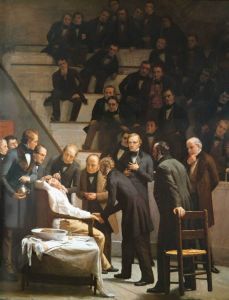 By the time the results of Koch's discovery had become widespread, and especially after the publication of a statistic by the sanitary inspector in San Remo - according to which the percentage of deaths from tuberculosis out of the total number of deaths in the municipality had risen from an insubstantial percentage in 1870 to 9.5% in 1875, 12.4% in 1884, 18.0% in 1889 and 30.0% in 1890 - the problem of contagion was tackled with a very different determination and fear.
By the time the results of Koch's discovery had become widespread, and especially after the publication of a statistic by the sanitary inspector in San Remo - according to which the percentage of deaths from tuberculosis out of the total number of deaths in the municipality had risen from an insubstantial percentage in 1870 to 9.5% in 1875, 12.4% in 1884, 18.0% in 1889 and 30.0% in 1890 - the problem of contagion was tackled with a very different determination and fear.
Until then it was cholera that was most feared in Sanremo, but from that decade onwards, due to the fact that the city was home to a large number of tisicians, now suddenly discovered to be contagious, it was tuberculosis that was to become a sort of collective nightmare.
Medical statistics showed that the disease was spreading among the local population and Sanremo risked being seen abroad no longer as a climatological treatment centre, but as a large sanatorium for tisicians.
This could have led to the exclusion of the Ligurian town from the great tourist circuit and consequently to the collapse of the local economy. The drastic drop in the number of holidaymakers in the 1990s was a sign of this.
The municipal administration was called upon to act, and act fast. And so, in the same decade, a service for the treatment of contagious infectious diseases was set up, to the benefit of the resident population; a project for a steam oven for disinfection was studied and implemented, followed by the organisation of a home disinfection service.
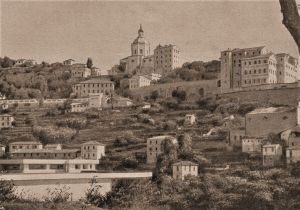 Lastly, the Mauriziano, already used as a lazaret, was transformed into a real hospital, and was also equipped with a special apparatus for disinfection, as well as a whole series of modern equipment of the time. In order to facilitate the constant presence of medical staff, a building was built in 1895 to house them, which was later called "The Doctors' House".
Lastly, the Mauriziano, already used as a lazaret, was transformed into a real hospital, and was also equipped with a special apparatus for disinfection, as well as a whole series of modern equipment of the time. In order to facilitate the constant presence of medical staff, a building was built in 1895 to house them, which was later called "The Doctors' House".
« ...which takes in the contagious hotels and pensions as well as the others who are without any proper attention. They get the best attendance possible under the superintendence of two appointed physicians. is provided with a grand apparatus for disinfection and in all cases, when a room has been infected, this as well as the supplies undergo an energetic disinfection". (original text) ».
The purpose of the disinfection service, which was the most important and effective measure taken by the administration, was to sterilise the rooms in the hotels and villas where tuberculosis patients had stayed and also to disinfect objects that might have been contaminated by the bacteria, while burning anything that, like foodstuffs, could not be sterilised. The service was compulsory and it was up to the hoteliers and tenants to request and pay for it. Failure to do so could result in heavy fines and the withdrawal of the licence.
The hysteria that afflicted many in those years meant that new precautionary measures, the most abstruse of which were constantly being invoked in the newspaper columns. There were those who, when it was still believed that it was the spit of people with consumption disorders that spread the germs, asked that all public places be provided with hermetically sealed spittoons to be disinfected daily; there were those who called for the creation of places and walks reserved for people with tuberculosis; and finally there were those who insisted that the regulations of the city police should include a ban on people with consumption disorders spitting on the ground.
In such a climate, the favourable decision taken by the municipal council - with a socialist majority - in 1903 regarding the proposal to establish a large sanatorium for the treatment of tuberculosis was strongly opposed.
Tourism had already begun to change in a modern direction. Towards the end of the century, the tourists who came for unavoidable health reasons were reduced to a minority and when the question of the sanatorium first arose, it was the members of the English, French and German colonies who protested, threatening never to return to Sanremo if the city was transformed into an infection foyer.
In the new century, the administration continued its fight against infectious diseases. To this end, rooms were built for the isolation of suspected infected persons, the entire health service was reorganised to favour the treatment of the infected, and a cabinet for clinical analyses was founded.
Before the Great War, there were still many projects to be implemented to combat contagious diseases.
In 1913 we read in the Report of the Municipal Council of San Remo:
« The isolation rooms for infectious diseases are no longer fit for purpose.... This need for new adequate premises for infectious diseases was felt especially in the English Colony, which proposed to build a small isolation hospital at its own expense... But as the English Hospital is only capable of a few beds, and will have to be reserved preferably for the English Colony, it is necessary that the city hospital be built next to it...
The project for the new hospital was studied by the Hygiene Office and is ready in all its details, including the disinfection station....».
However, the war interrupted the realisation of the projects under study and in the immediate post-war period, the city's resources, which had become very meagre due to the paralysis of the tourist movement, were directed towards essential work.
3 - The problem of waste disposal
With the creation of the aqueduct that conveyed the waters of the Argallo River to Sanremo, the municipal administration had created the most important prerequisite to solve the hygienic issue; it was now able to dispose of a sufficient quantity of water to wash the streets and the drains and to flush the sewers.
In the wake of the enthusiasm that the inauguration of the aqueduct aroused in the town, the Town Council decided to build a general sewerage system, but reserved the right to leave the project in abeyance, both because of the uncertainty of the best system to adopt and because of the insufficient financial means available.
In view of the economic possibilities and technical knowledge available at the time, a sewerage system was not an easy problem to solve. It was not until the second half of the 19th century that a number of European cities undertook such efforts, and the technology they employed was still largely experimental. Moreover, although there had been a heated debate on the effectiveness of the various systems for twenty years, there was absolutely no agreement among the scientists involved in these studies.
The reason for the sudden interest that the sewage question polarised was
«...without doubt, in the recognition that this question is closely related to how many other studies are being carried out to know the cause and origins of infectious mysmatico-contagious diseases, and to find the means to prevent and combat them. For it has been recognised beyond any doubt by physicians and hygienists that the cleanliness and clarity of the ground underneath buildings and public streets has an absolute influence on the purity of the air in dwellings and on the health of those who live there.
It was recognised that the germs of some of the dominant morbid infections, called bacterium, bacilli, microbes or whatever, when they are outside of living organisms, have their seat and life in the excretions emitted by those who were affected by the infections themselves, and that these germs propagate with great rapidity through the air and water, preserve their vitality in the excretions and rejection materials for a very long time. It can therefore be established, from this point of view, that the removal of waste materials from built-up areas as quickly as possible and in the best possible way is the primary duty of those responsible for the public good ».
Until the '70s, in the Sanremo area, the problem of collecting and evacuating rubbish and faecal matter from houses was not considered a problem affecting the community as a whole, and therefore falling on the shoulders of the municipal administration, but rather a problem concerning individual citizens, who provided their own houses with cesspits and periodically took care of emptying and transporting the excrement and household waste. The tasks of the municipality were completed with the evacuation of rainwater from the town, which was collected in special drains.
So in Sanremo, as in almost all Ligurian towns, there was only a rudimentary system of white canals, built under the street floor or on the surface, on one side of the streets. These canals generally introduced the "meteoric" water into the torrents or directly into the sea; only in some cases, similarly to what happened for the discharge water of some fountains, the white canals led the rainwater to lands surrounding the built-up area, where it was used for irrigation.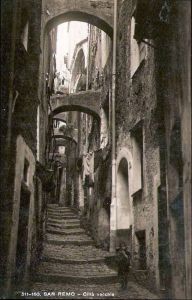 Such a system of small-scale drainage canals, designed exclusively to convey rain, had a serious defect. Rubbish of various kinds often ended up in the pipes, which stagnated and gave off pestilential fumes. This organic matter eventually clogged the channels, causing the roadbed to swamp.
Such a system of small-scale drainage canals, designed exclusively to convey rain, had a serious defect. Rubbish of various kinds often ended up in the pipes, which stagnated and gave off pestilential fumes. This organic matter eventually clogged the channels, causing the roadbed to swamp.
Rainwater hardly ever had the necessary pressure to unclog the pipes, taking the waste with it into the streams. But when this did happen, the organic substances ended up rotting in the bed of the dried-up streams.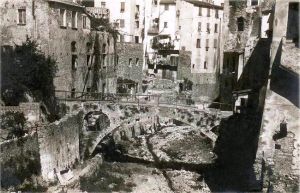 This situation, which was already unhygienic in itself, was complicated by the fact that many houses built near the city's watercourses fed their excrement and waste water directly into them. As a result, further deposits of fetid and putrescent matter formed in the riverbeds of the streams, « especially during the long dry periods, which certainly do not enhance the reputation of San Remo's balsamic breezes, so sought after by tourists ».
This situation, which was already unhygienic in itself, was complicated by the fact that many houses built near the city's watercourses fed their excrement and waste water directly into them. As a result, further deposits of fetid and putrescent matter formed in the riverbeds of the streams, « especially during the long dry periods, which certainly do not enhance the reputation of San Remo's balsamic breezes, so sought after by tourists ».
This serious problem was not solved even when the Carli aqueduct was completed in 1828 and the administration had a considerable amount of water available for the hygiene needs of the town. In fact, the water from the new pipeline, introduced at great pressure, was able to rinse the drainage canals, but not to carry away the rubbish from the riverbeds. For more than six months a year, therefore, the San Romolo, the San Francesco and the San Lazzaro were uncovered and stagnant sewage pipes.
Until the '70s, Sanremo depended on a system of "dry toilets", consisting of a hole in the floor of the building. This consisted of a hole in the floor of the house toilets, which was the end of a vertical conduit with an outlet into a room on the ground floor, where there was usually a cesspit. Liquid and solid organic substances produced by the users of the latrines, and sometimes the household garbage itself, were precipitated down the conduit without the aid of water, and ended up in the cesspit or in the collection tank, or simply accumulated in the room that housed them, until lack of space forced their removal.
The systems relied upon for the collection of excreta in the houses were different: there was the system of impermeable cesspools, the system of absorbent cesspools, the system of portable cesspools and the system of storage rooms. The first and third systems required a small amount of capital for their construction and installation and were generally used in bourgeois houses, while the second and fourth systems, which were easy to implement, were usually used in working-class houses. On the whole, the absorbent and impermeable cesspools were by far the most widely used expedient in San Remo.
The drawbacks that doctors and scientists recognised in the cesspool system were several. In the first place, whether they were absorbent or not, they were not waterproof, because even the masonry walls were subject to infiltration over time.
« ...it therefore happens that after a certain time the ground around the cesspools remains infected and soaked, for a more or less large area, depending on the greater or lesser porosity of the surrounding soil, with unclean and putrescible matter that makes the area we breathe infected and unhealthy and harmful. Nor is it difficult to understand how this infection can reach us.
The lowering of the underground water table draws in atmospheric air as a substitute, which penetrates into the cavities and porosities of the soil, overloading it with infected gases, while the subsequent raising of the water current in the permeable layer drives the infected air out of the vacuoles in the soil and into the inhabited areas. This exchange of air between the soil and the atmosphere occurs quite continuously and rapidly, especially in rainy seasons, and it is easy to see how it can exert a considerable influence on our dwellings ».
Secondly, the serious drawback of cesspools was that
« ...of the fetid emanations which from the upper tanks rise up to infect the flats one above the other, following the route of the pipes intended for the removal of excrement. By adopting cesspits of considerable size, so as not to be forced to evacuate too frequently the materials introduced into them, the result is that the excrement and domestic waste, remaining there in considerable quantities, in an atmosphere lacking in oxygen, undergo a kind of putrid fermentation, giving rise to deleterious gases such as ammonia, carbonic acid, carbon monoxide, hydrogen sulphide, a large part of which spreads in the homes ».
The cesspools, however, were seen as a necessary evil as they were of great importance to the economy of the San Remo area. The soil in Liguria is very poor, largely rocky and in the remaining part not very fertile.
Fertilising the land was an indispensable measure to make the harvest less thankless.
Chemical fertilisers were not yet used in the '80s and guano was very expensive. Fertilisation, and therefore the level of agricultural productivity in the San Remo area, thus depended to a large extent on the ability of the inhabitants of the capital to produce abundant and well-nitrogenated excrement.
This meant that the town's cesspits were emptied by the local farmers themselves, who for a long time were even prepared to pay for the precious material. But when the competition from guano began, the owners had to resign themselves to giving the farmers the contents of the wells in exchange for cleaning them.
The increased water supply that Sanremo had at its disposal, thanks to the Marsaglia aqueduct, inaugurated on March 12, 1885, created a great problem of survival for this age-old and tested system of evacuation of liquid and solid droppings. In fact, the new large quantity of water ended up, after domestic use, in the latrines.
Even, now that the fashion for the water closet was in vogue, thousands of litres of clean water ended up daily in cesspools. The result was that the excrement that was so useful for agriculture was disproportionately diluted and farmers began to lose interest in a product that had become inefficient and difficult to transport.
They began to pay for the service of emptying the wells, which now had to be carried out more frequently, as the pits filled up more quickly because of the water. And nobody liked the turn of events: it displeased the farmers, who lost the possibility of using large quantities of fertiliser free of charge, and it displeased the owners and tourists, who were financially damaged by the events, but above all who were now disturbed too often by the emptying of the pits.
In short, the municipal administration had done the right thing in deciding to build the sewer; this seemed to be the only solution to a problem that was becoming increasingly entangled.
However, the resolution of 28 May 1885 was more of a stratagem to gain time; the municipal finances were not flourishing after the aqueduct was built and the administrators were well aware that the sewerage system, even if it had been approved, could not be built for a long time.
However, time exacerbated the problems that were on the table. Between the end of the eighties and the beginning of the new century, in fact, the habit of illegally connecting cesspools to street canals became widespread in San Remo.
It was enough for the owners to connect the upper part of the pits to the sewage pipes, so that the liquid content could flow out; what remained of the solids could be sold to the farmers.
Technical comment:
In the 19th century, three different sewerage systems were tested: the mixed sewerage system, with large (French system) or small (German system) ducts; the separate sewerage system with continuous circulation (English system); the simple separate sewerage system (American system).
The mixed sewerage system provided for the creation of a single network of underground canals to receive waste material, kitchen waste water, rainwater, industrial waste water, public and private washing facilities, slaughterhouses, etc., and to evacuate it from inhabited areas into rivers or the sea, or to irrigate the countryside. This was the system adopted in large European cities such as London, Brussels and Paris, where there were two types of channels: the collecteurs and the égouts (collectors and sewers). The égouts, to which the secondary arteries coming from the houses were connected, ran under the streets and collected the water and unclean matter and poured it into the collecteurs, or main canals, which flowed downstream into the Seine.
This system was also in use in Berlin, Hamburg and Frankfurt, but instead of large-section conduits, small ovoid conduits were used, suitably fed by water to prevent the stagnation of waste materials.
The mixed sewer system was opposed by many scientists, who believed that sewage could, regardless of the quality of the materials used in their construction, seep through the walls of the pipes and pollute the surrounding soil.
Another serious drawback of this system was the formation of deleterious gases in the channels, produced by the fermentation of stagnant putrid matter, which were able to rise up to the houses. And this explained why once
« ...once the epidemic is introduced into a large city, it is impossible to stop it; it spreads certainly and rapidly through this underground and dark maze, which like a huge madrepora with a thousand tentacles, embraces in its fatal grip all the houses, all the families, and brings sickness and death there ».
The system of separate sewers with continuous circulation, used mainly in England, consisted of two sets of pipes: one for rainwater, the other for waste water and manure. For the latter, a continuous circulation was established by means of a special water conduit, which was fed into the sewage circuit and which, having entered pure, came out loaded with fertilising materials.
The conduits led this water to the countryside, where it was used for irrigation. The canalisation, in this system, was generally made of cast iron with large section pipes. In order to function, however, many litres of water per inhabitant were needed to be fed into the circuit every day.
The simple separate sewer system, widely used in the United States, involved the separation of rainwater and sewage pipes. At the upper end of the secondary channels of the rainwater circuit there were special inflow cisterns by means of which a considerable quantity of water could be poured into the channels, thus obtaining their rapid flushing. However, this system not only required a lot of water, it also needed steep slopes. It also required the dispersal of waste matter into rivers or seas.
The first project of a general sewerage system for the city of Sanremo was elaborated by the Asquasciati administration in 1890 and foresaw the construction of three large collectors in the bed of the San Romolo, San Lazzaro and San Francesco streams and secondary collectors to be carried out along the main city streets.
The system adopted by the plan was that of "tout à l'égout" (drainage).
Rainwater, rejection water and waste material were to be dispersed into the sea at a suitable distance from the shore in the section facing the town.
The second project, by engineers Losio and Pagliani of Turin, drawn up in 1901, was undoubtedly more complex and articulated than the previous one. The system they adopted was that of a simple separate sewerage system, using a convenient distribution of automatic water "outlets". The sewage was to flow into the sea, a hundred metres away from the beach, at the level of the San Bernardo stream, purified using the biological system.
The project provided for the construction of four main collectors running parallel to the beach, along Via Cavallotti - Garibaldi - Palazzo, Via Vittorio Emanuele, Via Roma and Corso Carlo Alberto, on which the secondary street canals converged, collecting the sewage from the houses through tertiary pipes, The secondary street canals converged on these, collecting the sewage from the houses through tertiary pipes, sloping from top to bottom so that the water and filthy matter could be channelled towards the lowest part of the city, eighty metres west of the railway station, along Corso dell'Imperatrice, from where a single general sewer would take the sewage to the mouth of the Bernardo stream.
The last general sewerage project drawn up for Sanremo before the World War was that of the firm Zucchetti & Brugnatelli of Milan, dated 1912. The two engineers from Lombardy agreed with their predecessors from Piedmont that the system of mixed sewerage should be discarded and that the simple separate sewerage should be adopted, which was better suited to the topographical characteristics of the town.
« Under the new Zucchetti-Brugnatelli project, the city's water is disposed of by two main collectors: a western collector which collects the sewage from the city centre and the western region and pours it into the sea near the cemetery; and a smaller collector towards the east which conveys the sewage from the corresponding region and pours it into the sea beyond San Martino ».
Even during the debate on the sewerage issue in the town council meetings, the split between "pro-tourists" and those in favour of development based on traditional economic activities continued. The former wanted the general sewerage system in order to solve the hygiene problem once and for all, to prevent epidemics and to satisfy the wishes of the foreign colonies; the latter - whose watchword was laissez-faire - opposed its construction, mainly because they were concerned about the repercussions that the end of the large supply of fertiliser would have on agriculture.
There was also a centrist group within the municipal council, who wanted the problem of disposing of urban waste to be solved without depriving agriculture of the fertiliser it needed. In Sanremo, this meant no sewage system, as it was not possible at the time, due to the high costs involved, to channel the sewage to the cultivated land, almost all of which was hilly.
The most representative figure of this faction was the engineer Giacomo Picconi, municipal councillor and then councillor in the last period of the Asquasciati administration, author of an important study on the sewerage issue. Picconi was a firm believer in strict regulation of sewage evacuation methods and advocated the adoption of the system of mobile ditches for the complete removal of liquid and solid excrement, which was successfully practised in many German cities.
« The service of these pits is very simple, if they have been set up large enough, all the more so because they can be done very usefully by a company set up for this purpose. The establishment of such a company would not require a great deal of start-up capital. The mobile pits could also be used oil barrels, suitably circled and fitted with a hermetically sealed lid.... Two barrels per house would be sufficient for the replacement.
The removal of these barrels would be done periodically every four or five days, at the most convenient times of the night, without causing annoyance or disturbance to the tenants, by means of wagons on which the empty replacement barrels could be transported and the full ones exported ».
To solve the problem of the evacuation of urban waste, in Sanremo, between 1885 and 1915, a general sewerage system was not built, as hoped by the "pro-tourist" bourgeoisie gathered around the mayor-banker Asquasciati; the system of cesspools was not made compulsory, as wanted by the technicians represented in the council by the engineer Picconi; nor was any action taken, as demanded by councillor Viale and other exponents of the "anti-tourist" party.
The measures that were taken, however, were such that no side was completely dissatisfied. In fact, some sewers were built, the sewage evacuation system was regulated, but at the same time the discharge of sewage into the street canals was tolerated.
At the end of the century there were two different kinds of unauthorised sewage connections: those connecting cesspits, generally in their upper part, to the street canals, and those connecting latrine conduits directly to the stream bed. In the first case, only liquid excrement ended up in the bed of the San Romolo, San Francesco and San Lazzaro streams, while in the second case all the substances thrown down the gargoyles of the toilets ended up there: liquid excrement, faecal matter, domestic water and even rubbish.
The municipality tolerated this situation, considering it to be temporary, and thought that in a short time, with the construction of the general sewerage system for the town, the matter would resolve itself. However, no sewerage system was built for the entire period in question, and the fear of the stench emanating from the torrents often led to petitions and letters of protest addressed to the public administrators.
However, the municipal council remained largely deaf to these complaints and sometimes even authorised the construction of private sewers, reserving the right to use these illegal connections. On this point, the "anti-tourists" in favour of laissez-faire had undoubtedly won.
In clear contradiction to this permissive attitude, however, in 1883 the administration approved the new hygiene regulations, which contained important norms aimed at rationalising the system of collection and disposal of urban waste, norms whose "Picconian" matrix could be felt.
« The articles of the San Remo hygiene regulations for the soil and the built-up area prohibited the connection of cesspools and latrine ducts to streams and white canals; they banned the system of absorbent wells and storage rooms, while authorising impermeable cesspools and mobile cesspools; they required latrines to have siphons, hermetic closures, hydraulic devices for draining water and vent pipes for noxious gases; They introduced a compulsory odourless draining of pits; they fixed night-time hours for cleaning and emptying wells and for transporting faecal matter; they prohibited the use of natural fertiliser in the urban area; they required owners to connect their cesspits to the general sewerage system once it had been built; and they prohibited the dumping of rubbish on meadows or in streams.
Fines and penalties were envisaged for those who transgressed these rules, but of course these were not simple administrative measures that could solve the problem of the hygienic conditions of urban streams ».
A third type of measure taken by the municipal council between 1885 and 1915 on the issue of urban waste disposal concerned the construction of sewers and the development of the city's stream beds with a view to their future conversion into sewerage collectors.
This was the first step towards the construction of a general sewerage system for the town, the main demand of the pro-tourist camp.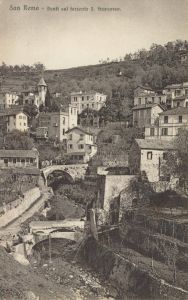 Sewer lines were built to connect public buildings such as the abattoir, hospital, station, wash-houses and public toilets, which required constant disposal of large quantities of water and unclean materials, and along the main town streams. The sewage was discharged into the sea in the stretch facing the town.
Sewer lines were built to connect public buildings such as the abattoir, hospital, station, wash-houses and public toilets, which required constant disposal of large quantities of water and unclean materials, and along the main town streams. The sewage was discharged into the sea in the stretch facing the town.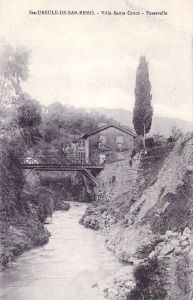 The San Romolo, San Francesco, San Lazzaro and Foce streams were therefore provided with sewage pipes a few years later.
The San Romolo, San Francesco, San Lazzaro and Foce streams were therefore provided with sewage pipes a few years later.
However, the hygienic condition of the streams, although improving, remained precarious, especially because of the numerous illegal sewer connections.
In the new century, the beds of the San Francesco, San Lazzaro and Foce were partially covered and restored, and the San Romolo, the city's most unhygienic stream, was completely covered and restored.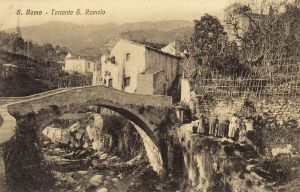 The history of the latter is emblematic. It was partially covered as early as 1878/79, when Corso Umberto I was built. In the 1990s, plans were made to cover it completely, reorganise its bed and transform it into a sewage conduit. However, the current administration simply built a sewer along its bank.
The history of the latter is emblematic. It was partially covered as early as 1878/79, when Corso Umberto I was built. In the 1990s, plans were made to cover it completely, reorganise its bed and transform it into a sewage conduit. However, the current administration simply built a sewer along its bank.
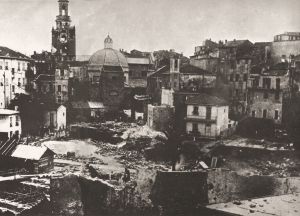 In 1902 part of its bed was paved, joining the garden in front of the Convent of the Turchine with the small square behind the Church of San Siro (then called Market Square), creating what was to become the new Market Square.
In 1902 part of its bed was paved, joining the garden in front of the Convent of the Turchine with the small square behind the Church of San Siro (then called Market Square), creating what was to become the new Market Square.
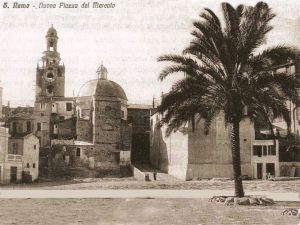
In 1910 a second partial covering was carried out to make it possible to enlarge the Market Square. 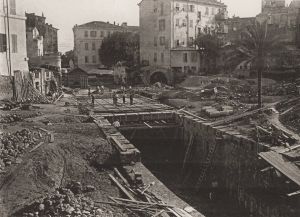 In 1912 it was again decided to cover it completely; the Natta-Soleri administration then asked for recognition of the public utility of the work and the
In 1912 it was again decided to cover it completely; the Natta-Soleri administration then asked for recognition of the public utility of the work and the 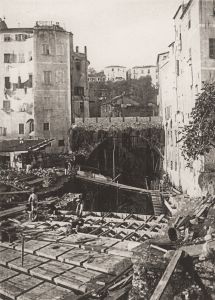 granting of a soft loan to make the work possible.
granting of a soft loan to make the work possible.
Between 1913 and 1914 the roofing was extended to Via Morardo and the Ciapella Bridge, thus completing the square, which in 1917 was named after Sanremo's Heroes.
Then came the war and the question of the hygienic conditions of San Romolo was put aside.
In the post-war period, however, it was discussed again.
In 1918, in fact, a popular petition reported the seriousness of the situation directly to the prefect, who commissioned the health inspector to carry out an inspection.
The results of this inspection confirmed the need to take care of this watercourse again.
« The San Romolo torrent, as it flows through the built-up area, receives water from oil mills, waste water from houses and wash-houses, and all the other sewage and domestic waste that is illegally poured into it by the tenants of the houses next door, as well as water from washing the streets. The bed of the torrent, both in the uncovered part and in the part below the streets, is for the most part permeable, with such slopes and counter-slopes as to form here and there more or less deep pools, where the water stagnates and decomposes. The bottom of these puddles consists of a layer of decomposing slime from which bubbles of putrid gas are continually rising; which sometimes, and because of their abundance, and the action of certain winds, invade nearby houses, forcing the tenants to barricade themselves in them....»
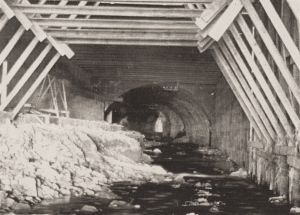 The health officer recommended paving over the river bed and covering it completely, but the mayor, when forwarding the report to the prefect, added: « I believe that this is not the time to solve the complex problem of settling the streams that flow through the town, which is connected with the problem of the town sewage system ».
The health officer recommended paving over the river bed and covering it completely, but the mayor, when forwarding the report to the prefect, added: « I believe that this is not the time to solve the complex problem of settling the streams that flow through the town, which is connected with the problem of the town sewage system ».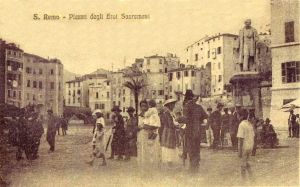 This consideration stemmed from the fact that the worst hygiene situation in the streams was naturally in the summer, when the heat caused the organic substances in the stream beds to rot. In contrast, during the tourist season, which began in October and ended in April, the rains provided sufficient water to remove these substances from the riverbeds; furthermore, the low winter temperature prevented the rapid decomposition of the waste and finally the action of the sea winds swept away the miasmatic effluents.
This consideration stemmed from the fact that the worst hygiene situation in the streams was naturally in the summer, when the heat caused the organic substances in the stream beds to rot. In contrast, during the tourist season, which began in October and ended in April, the rains provided sufficient water to remove these substances from the riverbeds; furthermore, the low winter temperature prevented the rapid decomposition of the waste and finally the action of the sea winds swept away the miasmatic effluents.
However, there was no shortage of complaints and protests, especially from citizens who lived in the town all year round.
The municipality's resources were abundant thanks to tourism, but not infinite. In fact, it found the funds to build a new hospital with an adjoining disinfection service or to municipalise the Aqueduct, but it could not find the sum that was needed to equip itself with a modern sewage system.
Once again, therefore, the resolution of the problem of the hygienic conditions of the urban streams, under the illusion that the sewerage system would soon be built, was postponed.
However, until the thirties, no administration undertook the financial burden that such a construction would entail, and for this reason we can conclude that, in spite of the efficiency achieved by the urban cleaning service, the sanitary organisation and the water supply, the hygienic issue in Sanremo of the belle époque was never completely resolved.
As soon as the tourists left, the residents had to live with the effluents of the torrents, full of excrements, garbage and waste water.
But Sanremo was a "ville pour les autres" and the problems were taken into consideration only when they had a direct and harmful influence on the life of the foreign colony; the huge expenses were tolerated only when they were aimed at tourism, which gave prosperity to the city.
The general sewerage of the town was not a work that would have brought great benefit to the hivernants, but rather to the residents, and for the people of Sanremo such expenses could not be met.
And so the Sanremo of the belle époque, owner of one of the most efficient aqueducts in Europe and of a luxurious casino, agreed to perpetuate an archaic and unhygienic system of urban waste disposal, which affected the cleanliness of the streams and compromised, at least for six months of the year, the general healthiness of the town.
4 - Public lavatories
The Municipal Council of 14 June 1872 approved the construction of public lavatories (vespasiani) to be placed at the railway station, in the public garden, on Piazza Colombo, along 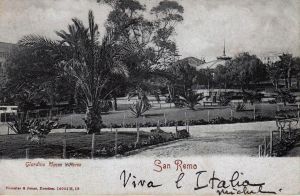 Via Vittorio Emanuele, and elsewhere the Municipal Council deemed necessary.
Via Vittorio Emanuele, and elsewhere the Municipal Council deemed necessary.
It was suggested that they should be built "with a garret like those seen in Nice".
In 1885, on the occasion of the renewal of the contract for the distribution of chairs in the public gardens, the contractor was asked to take care of the public toilets built in the Maria Vittoria garden.
At the meeting of the Municipal Council on 5 June 1891, the Councillor for Public Works, Giacomo Picconi, gave a brief report on the proposal by the Italian representative of the "Compagnie nouvelle des chalets de commoditè", based in Paris, to obtain a 30-year licence
« to establish and operate in the city a pavilion or kiosk for the use of public latrines, and two luminous columns with compartments for urinals.
The referent shows how with one and the other the intention is to meet a felt need, and how the two types of construction correspond fully to the purpose. The Society would provide for their construction and operation by means of an annual grant, while the Municipality would provide the necessary water and gas. The annual expense would be about £600; after 30 years, the kiosk and columns would pass into the ownership of the Municipality without any further expense.
The latrine would be located on the corner of Piazza Mercato, facing the Education Building, so that it would not present any inconvenience, even if the square itself were to be enlarged.
He then proposes to approve in principle the installation of the latrine and the two urinals, and to instruct the Council to prepare a special agreement, to be presented in due course to the Council for approval ».
Pio Carli and Antonio Rubino, the councillors, find the proposal perfectly acceptable, but before binding the Municipality with a long-term concession, they would like a special experiment to be carried out.
« Since no doubts could arise regarding the good outcome of the proposed system, such as the one that is in use and has proved its worth in the most important cities, especially in Paris, Picconi does not see how reasonable it is to expect the Company to incur a very considerable expense under the condition of a trial, and therefore insists on the proposal ».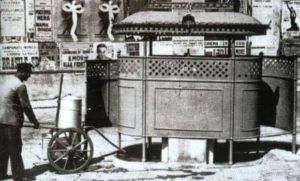 The President comm. Bartolomeo Asquasciati spoke in favour of the proposal formulated by Rubino in the following terms: « The Council, taking into consideration the proposal of the Society, commissions the Council to prepare a special agreement for the installation and operation of the latrine and the two public urinals ».
The President comm. Bartolomeo Asquasciati spoke in favour of the proposal formulated by Rubino in the following terms: « The Council, taking into consideration the proposal of the Society, commissions the Council to prepare a special agreement for the installation and operation of the latrine and the two public urinals ».
The Council, by full vote, resolves to adopt Councillor Rubino's proposal.
In 1896, councillor Bartolomeo Odorizzi presented to the municipal council on 15 December an interpellation he had submitted « on the erroneous construction of the city's public urinals, both in terms of shape and size and in terms of decorum and decency ».
He reviewed the various technical and aesthetic defects he had found in the urinals in Via Morardo, the one next to the Municipal Theatre and the other against the east wall of Palazzo Borea.
He suggested a number of norms to which the system of such constructions should conform, so that they might better fulfil their purpose.
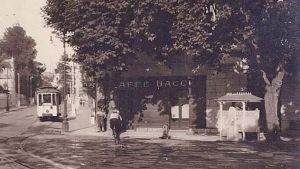 The Municipal Council of 18 June 1900 discussed the project "for a public toilet to be erected in Via Umberto I, in the flowerbed to the south of Via Roma", for the construction of which the expenditure of £ 7,500 will be required.
The Municipal Council of 18 June 1900 discussed the project "for a public toilet to be erected in Via Umberto I, in the flowerbed to the south of Via Roma", for the construction of which the expenditure of £ 7,500 will be required.
The Councillor, Engineer Antonio Tornatore, describes the technical and economic details of the project itself, of which he then proposes a modification consisting in replacing cement plaster with glazed tiles on the outside of the building.
There follows a brief discussion on the choice of location, with Councillor Paolo Marini suggesting that it would be preferable to locate the building in the square in front of the railway station, while Councillors Dr. Gio Battista Onetti and Captain Gio Battista Goetta consider it much better. The latter wishes and recommends that, in the near future, provision should be made for the erection of other cessatoriums in suitable locations to the east and west of the City.
Put to the vote, the project is unanimously approved.
(sources: elaboration from texts by Massimo Scattareggia "Sanremo 1815-1915; Giuseppe Silingardi "C'era una volta a Sanremo")




